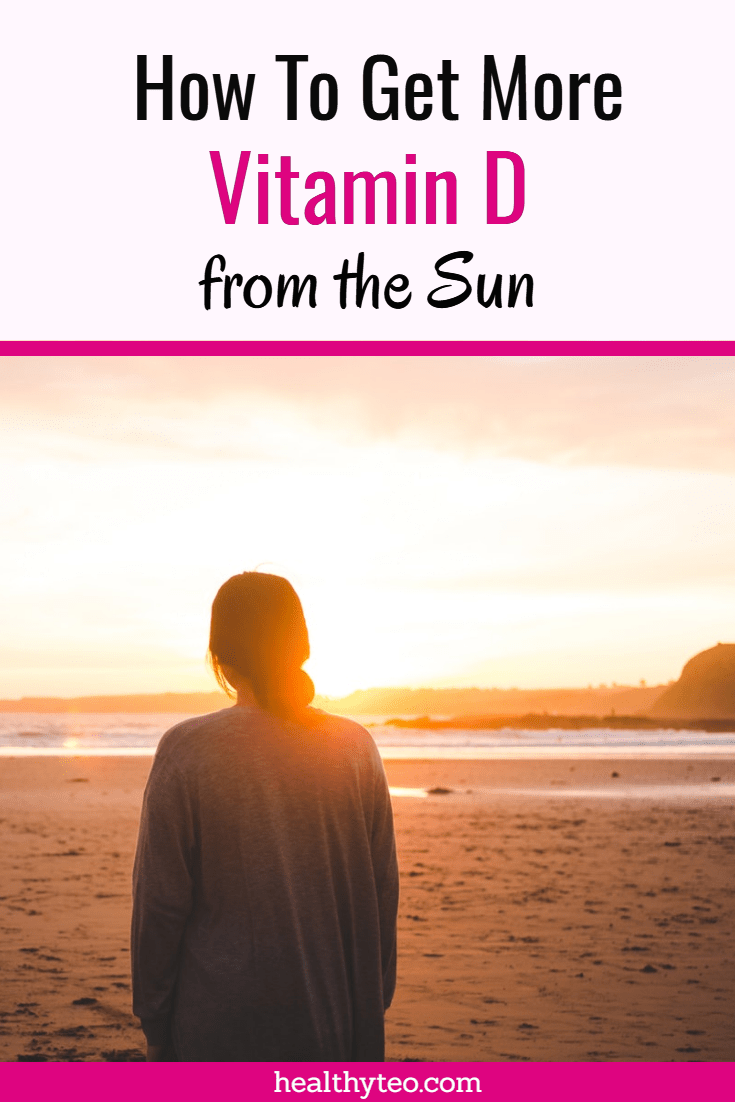How to get more vitamin D from the sun? Is this the question that you are asking yourself? Or is it better to take vitamin D supplements?
Yes, maybe we have the answers here. After reading many researchers on vitamin D and how sun exposure affects our health, we found some interesting things.
These findings can help you to understand what is vitamin D, how to get it from the sun, and how much of this essential vitamin is enough.
But first, let’s see what is vitamin D and why it is so important for our health.
What is vitamin D?
Vitamin D is one of the 13 vitamins discovered in the early 20th century by doctors studying nutritional deficiency diseases.
Ever since scientists have defined vitamins as organic (carbon-containing) chemicals that must be obtained from dietary sources because they are not produced by the body’s tissues.
Vitamins play a crucial role in our body’s metabolism, but only tiny amounts are needed to fill that role.
Although vitamin D is firmly enshrined as one of the four fat-soluble vitamins, it is not technically a vitamin. True, it’s essential for health, and only minuscule amounts are required.
But it breaks the other rules for vitamins because it’s produced in the human body, it’s absent from all-natural foods except for fish and egg yolks, and even when it’s obtained from foods, it must be transformed by the body before it can do any good.
As our habits change, most of us cannot rely on our bodies to produce vitamin D in an old-fashioned way. Instead, we increasingly depend on artificially fortified foods and pills to provide this vital nutrient.
Coming full circle in the modern world, this substance may come to fit the technical definition of a vitamin.
Vitamin D is not one chemical but many. The natural type is produced in the skin from a universally present form of cholesterol, 7-dehydrocholesterol.
Sunlight is the key: Its ultraviolet B (UVB) energy converts the precursor to vitamin D3. In contrast, most dietary supplements are manufactured by exposing a plant sterol to ultraviolet energy, thus producing vitamin D2.
Because their function is almost identical, D2 and D3 are lumped together under the name vitamin D – but neither will function until the body works its magic.
The first stop is in the liver, where vitamin D picks up extra oxygen and hydrogen molecules to become 25-hydroxyvitamin D, or 25(OH)D.
This is the chemical that doctors usually measure to diagnose vitamin D deficiencies. But although 25(OH)D is used for diagnosis, it can’t function until it travels to the kidney.
There it acquires a final pair of oxygen and hydrogen molecules to become 1,25 dihydroxyvitamin D; scientists know this active form of the vitamin as 1,25(OH)2D or calcitriol, but for ordinary folks, the name vitamin D is accurate enough.
How do you get vitamin D from the sun?
The sun is our best natural source of vitamin D. Spending even a short time in the sun can provide the body with all of the vitamin D it needs for the day. According to the Vitamin D Council, this could be:
- 15 minutes for a person with light skin
- a couple of hours for a person with dark skin
Very few foods contain significant amounts of vitamin D, so people can ensure they get enough of the vitamin by scheduling regular time outdoors.
When the sun’s ultraviolet B (UVB) rays hit a person’s skin, processes inside the tissue start making vitamin D for the body to use. It is essential to remember, however, that too much sun exposure can burn the skin and potentially lead to skin cancer.
Vitamin D helps the body to absorb calcium, which is one of the main building blocks of bone. The body also needs vitamin D to keep the nerves, muscles, and immune system working properly.
Vitamin D deficiencies can cause soft bone conditions such as rickets or osteomalacia, and the porous, fragile bone condition called osteoporosis.
Tips for getting vitamin D from the sun
When the sun’s rays hit the skin, processes inside the tissues start making vitamin D.
People do not need to get a tan or burn to get vitamin D from the sun. The body will make all the vitamin D it needs for a day in about half the time it takes the skin to burn.
Many factors affect how much vitamin D a person gets from the sun, such as:
Time of day
The skin produces more vitamin D when in the sun during the middle of the day, the time it is at its highest point in the sky. When spending prolonged time in the hot sun, wear sunscreen, and stay hydrated.
Amount of skin exposed
The more skin a person exposes, the more vitamin D the body will make. Exposing the back, for instance, allows the body to produce more vitamin D than just the hands and face.
Skin color
Pale color skin makes vitamin D more quickly than darker-colored skin.
Where a person lives about the equator also has a significant impact on how much vitamin D their bodies can make.
In the United States, people in the sunnier southern states will find it easier to meet their vitamin D needs with sun exposure than those in the northern states. This is especially true in the winter months when the sun is lower in the sky.
Frequent, moderate exposure to the sun is healthful, but prolonged exposure can be dangerous.
It is important to note that when someone stays in the sun so long that their skin burns, they have a higher risk of developing skin cancer.
Current advice is for people to stay in the sun for half as long as it takes their particular skin type to burn before covering up and retiring to the shade. This should give them all the vitamin D they need without increasing the risk of skin cancer.
What factors prevent you from getting vitamin D from the sun?
Vitamin D deficiency is a possible risk for older people.
Wearing sunscreen limits the body’s ability to make vitamin D. However, spending time in the sun without sunscreen can cause sunburn and may contribute to the development of skin cancer.
The body cannot make vitamin D when exposed to the sun’s rays through a window as the glass blocks the sun’s UVB rays.
Some people’s skin is less able to make vitamin D than others. Others may not be able to adequately release vitamin D into their blood circulation from fat cells.
Also, certain individuals may not activate vitamin D in a usable state. These people may find themselves at risk of vitamin D deficiency, including:
- older people
- with darker skin
- people who are obese
- with kidney or liver disease
The more vitamin D you take, the better? Not.
Thomas Carpenter, MD, Yale Medicine pediatric endocrinologist and director of the Yale School of Medicine’s Center for X-Linked Hypophosphatemia
That’s a misconception. Vitamin D is stored in fat. So, if you’re a small person and getting large doses, you have less available storage, which means vitamin D goes into your blood and you may absorb too much calcium, creating a toxic situation.
And it’s unclear how long you have until you exceed the upper limits of vitamin D intake before it becomes dangerous. (Modest increases above the RDA are not likely to cause harm.)
Just recently, I treated an infant whose blood vitamin D level was in the hundreds when it should have been between 20 and 50 nanograms/milliliter (ng/mL).
The child, who developed high blood calcium (hypercalcemia), had to be hospitalized and treated with several types of medications to get the calcium levels down to normal levels.
You can now get 50,000 IU tablets over the counter. There are patients with specific issues who might need a prescription for high levels of vitamin D, but for most people, that amount will raise your vitamin D level too high.
When shopping for supplements, always look for ones that offer the daily recommended allowance (RDA) you need for your age bracket: For most healthy people, it’s 600 IU per day, but for people over age 70 who need a little more—it’s about 800 IU.
That’s because, as people age (women after menopause, in particular), the less efficiently synthesize vitamin D and absorb calcium. Babies should be getting smaller amounts in their first year of life, between 200 and 400 IU.
It used to be simple: just get a “healthy” tan and your body will make all the vitamin D it needs. Desk jobs and sunscreen have changed all that, just as research is underlining the importance of vitamin D and suggesting its possible role in preventing many health problems.
That makes vitamin D a dilemma of modern life that has a modern solution: eating fish and drinking some low-fat fortified milk, along with judicious doses of vitamin D supplements.
Conclusion: It is not so hard to get vitamin D from the sun. It is the best natural source for this essential vitamin. But these days where we spend so little time out in nature it is not so bad to consult with your doctor about vitamin D supplements.
But as we saw from all the above the best source and the best way to get the daily dose of vitamin D is from the sun. That’s why it is called ”sunshine vitamin”.

Sources: health.harvard.edu ncbi.nlm.nih.gov medicalnewstoday.com




